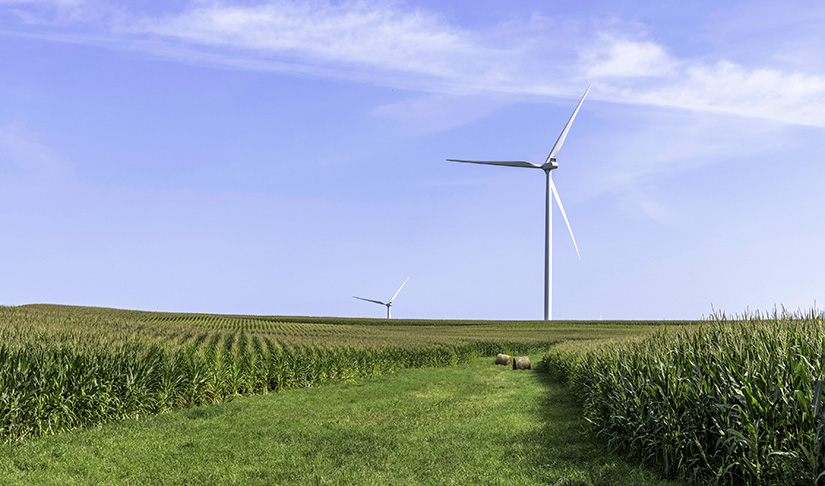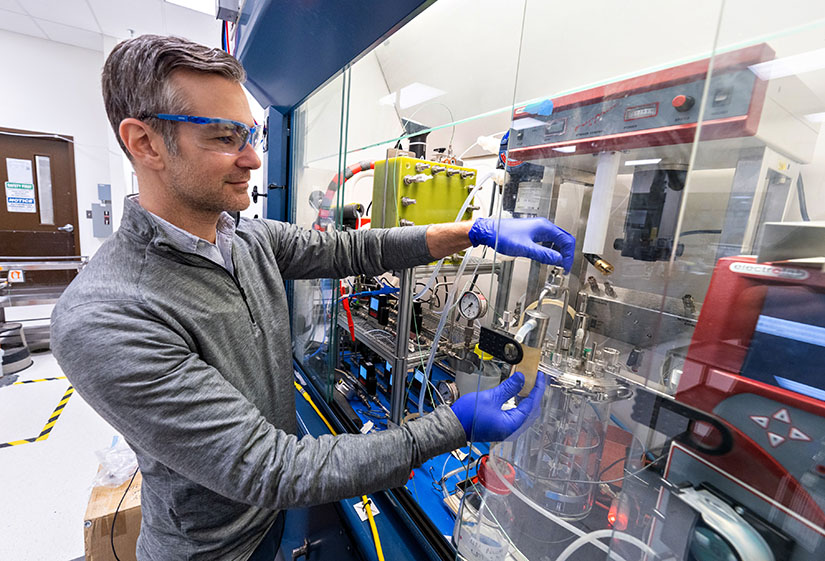New Consortium Advances Technologies That Use Renewable Electricity To Turn Carbon Dioxide Into Fuel
What if Biorefineries Could Produce 45% More Fuel With Fewer Emissions—All With the Same Amount of Land and Corn?

Wind and cornfields are about as Midwestern as it comes, and the data back it up. States that grow the most corn—places like Iowa, Minnesota, Nebraska, and South Dakota—are also the windiest in the country, according to the U.S. Department of Energy’s (DOE’s) 2022 Land-Based Wind Market Report.
Those abundant wind and corn resources are contributing to the region’s leadership in renewable energy. Every year, Midwest states produce millions of gallons of ethanol and thousands of kilowatt-hours (kWHs) of electricity from wind farms—energy sources already helping lower greenhouse gas emissions.
But their utility at cutting emissions could just be getting started. Scientists at the National Renewable Energy Laboratory (NREL) and other DOE national laboratories are developing electrolyzers that harness cheap electricity from wind turbines to turn carbon dioxide (CO2) waste into "e-fuels," short for electrofuels.
“There is enough space in U.S. corn fields to install wind turbines to convert all CO2 from ethanol production into fuel,” explained NREL scientist Michael Resch.
As the principal investigator for the CO2 Reduction and Upgrading for e-Fuels Consortium (CO2RUe), funded by DOE’s Bioenergy Technologies Office, Resch leads a team of researchers working to unlock the potential of CO2 electrolyzers and other technologies that enable e-fuels. If successful, the new consortium—which includes researchers from NREL as well as Lawrence Livermore National Laboratory, Argonne National Laboratory, Lawrence Berkeley National Laboratory, and Oak Ridge National Laboratory—could enable ethanol plants to reduce emissions while producing millions more gallons of fuel every year.
E-Fuels Are Made From Electricity and Carbon Dioxide

Drawing energy from nearby wind turbines, solar farms, or even nuclear power plants, electrolyzers transfer electrons to reduce carbon-containing molecules like CO2 into more energy-dense compounds and intermediates. The products from such reactions can then be further upgraded to produce e-fuels.
Others can be used as intermediates to make larger fuel molecules like jet fuel or gasoline. For example, CO2RUe researchers are exploring how to pump intermediates such as formate/formic acid, carbon monoxide, and hydrogen into large tanks brimming with microbes, which refine the chemicals into even more complex and valuable e-fuels, including sustainable aviation fuel.
At the molecular level, e-fuels can look identical to fossil fuels. In fact, companies and consumers can use many of them in the same tanks and engines without any modifications or upgrades. Zoom out, however, and the differences in the fuels become starkly clear.
“Across their life cycle, e-fuels can have dramatically lower land, water, and greenhouse gas footprints than fossil fuels,” Resch explained. “As a result, they could be key for decarbonizing economic sectors, such as aviation, maritime, freight, chemical manufacturing, and heavy industry.”
CO2RUe aims to lower technical and economic barriers for e-fuel technologies through a focused research and development (R&D) approach. Its initial 11 projects set a range of technical targets, from determining where electrolyzers might be installed and improving their efficiency in the lab to engineering microbes used in fermentation.
Previous NREL analysis suggests such R&D could make e-fuel technologies cost-effective in the coming years. Still, questions remain about the costs, risks, and technical challenges of making e-fuels at scale—questions CO2RUe researchers will examine and answer.
E-Fuels Could Advance Federal Climate Goals
Every hour, a typical 50 million-gallon-per-year ethanol plant in the United States—be it in Iowa or northern Ohio—releases around 14 tons of carbon dioxide, a natural byproduct of fermentation. Year after year, costs for electricity from neighboring wind farms have fallen, as taller turbines better capture valuable Midwestern wind.
According to Resch, CO2 electrolysis could integrate and mobilize both technologies to advance climate goals. For example, technologies already exist to upgrade ethanol into sustainable aviation fuel, supporting the federal government’s Sustainable Aviation Fuel Grand Challenge that aims to produce 35 billion gallons of the low-carbon jet fuel by 2050.
“Using CO2RUe technologies, we can convert those 14 tons of CO2 emissions into 18 million more gallons of ethanol every year,” Resch said. “And that’s just one ethanol plant. We are talking about a huge new potential source of low-carbon energy on practically the same land footprint.”
Learn more about CO2RUe.
Last Updated May 28, 2025
